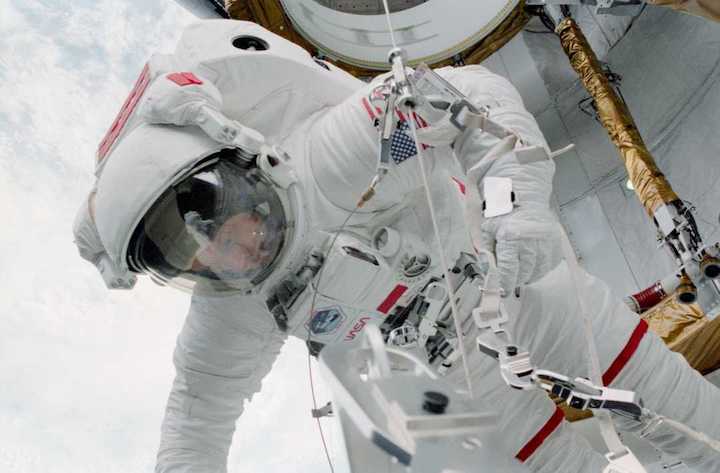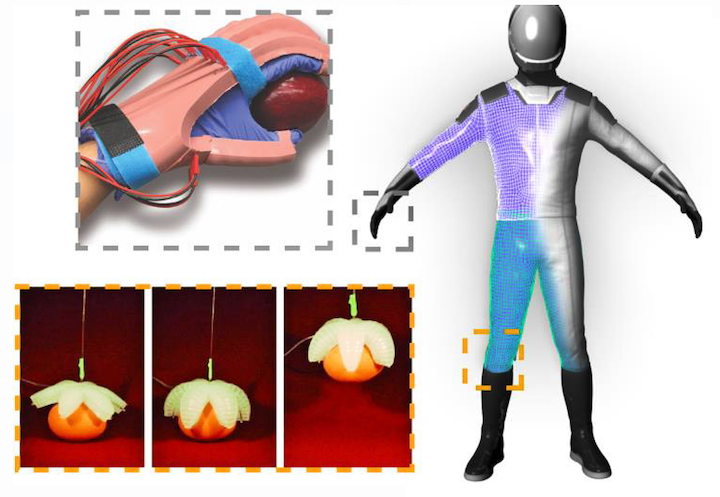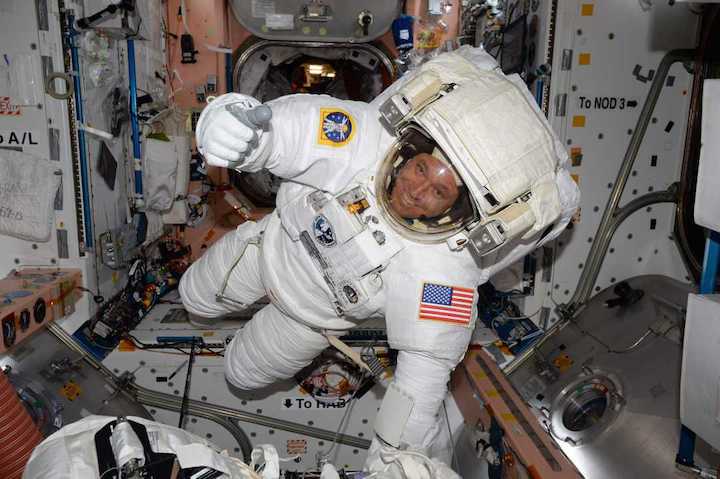10.05.2019
When astronauts Story Musgrave and Donald Peterson conducted the space shuttle program’s first spacewalk in 1983, they probably wouldn’t have imagined their spacesuits would still be in use on the International Space Station some 36 years later.
Not only are they still in use but the suits, intended to last 15 years, are currently the only ones available for astronauts whizzing around Earth at thousands of miles per hour.
Now, as NASA prepares to head back to the moon, the agency must scramble to develop a next-generation suit or the next American astronauts will be forced to don some hand-me-down, 1980s equipment.
Sure, the suits get updated after six years in orbit or 25 spacewalks, but with outdated technology and only a limited quantity available, the fact of the matter is the nearly 40-year-old suits NASA employs will not serve the needs of future moonwalkers.
The current spacesuits are expected to last until 2028 – four years after NASA hopes to land astronauts on the moon again. But a series of incidents and issues from the spacesuits suggests the need for change is more urgent. A recent example is the all-female spacewalk cancellation in March, which instead had a male and female astronaut perform the walk.
NASA has known for a while that it needs to update its spacesuits. The agency's Aerospace Safety Advisory Panel reiterated the urgency to develop the next-generation suit during a meeting last month.

In 2017, a similar report by NASA's inspector general came to the same conclusion and stated "the agency remains years away from having a flight-ready spacesuit capable of replacing the EMU or suitable for use on future exploration missions."
EMUs, or Extravehicular Mobility Units, are the current suits used on the ISS.
Considered to be a “mini spacecraft” in itself, the spacesuit astronauts currently wear to survive the harsh environment of space is complex and requires major modifications based on the user.
"The EMU, of course, is very bulky. It's a big, bulky, awkward suit to work in," former NASA astronaut Winston Scott told FLORIDA TODAY. "But your life depends on it. It is a totally self-contained life support system."
Since the retirement of the shuttle program in 2011, "NASA has had limited ability to return the EMUs from the ISS because only one of the commercial vehicles that ferry supplies to the station has the capability to return items to Earth," according to the inspector general's report.
"As a result, astronauts are using the EMUs for much longer periods of time between maintenance and refurbishment than originally intended," the report reads.
And only 11 of the 18 "EMU Primary Life Support System units," backpack-like structures required to keep astronauts alive when conducting spacewalks, are still in use. Five were destroyed in the Challenger and Columbia disasters as well as the SpaceX cargo mission that broke apart in 2015. Another was lost during ground testing and the last was built for certification only and is not suitable for flight.
NASA has had years to develop a next-generation spacesuit, but a "lack of a formal plan and specific destinations for future missions has complicated spacesuit development," the report noted.
Starting in 2005 with the establishment of the Constellation program, which called for the development of a suite of vehicles to take astronauts back to the moon and beyond, NASA has spent almost $200 million on three spacesuit development efforts.
On May 1, NASA said on Twitter there would be a "transition suit" for the first mission to return to the moon that would include modern designs for astronauts to explore the lunar surface. As to what those advancements will be or what the transition suit will entail, the agency is still unsure.
"We’re looking at internal and external options for a transition spacesuit for the Moon 2024 landing with American astronauts as well as options for modern spacesuits for sustainable surface missions," NASA spokeswoman Cheryl Warner said.
Possible future spacesuits

On the local front, Florida Institute of Technology academics have their own ideas on how to upgrade NASA's spacesuits.
In 2016, Ondrej Doule, director and founder of the university's Human Spaceflight Laboratory, along with students and team members, won the grand prize for their design of the interior of a single-person spacecraft in the Genesis Engineering Solutions competition.
The "Wholly Human Integrated Single Person Spacecraft" could replace the current spacesuits, Doule said. Instead of modeling the single-person spacecraft to look like a suit, the device would essentially become a mini-spacecraft with robotic arms and would have enough room for one astronaut.
Not only could any astronaut perform spacewalks regardless of their body shape, the walks would also be safer to perform because the robotic arms, operated by the astronauts, would do all the repairs needed outside of the space station instead of actual people, Doule said.
Though NASA does not know what the next spacesuit will look like, the agency is casting a wide net in its search.
As part of the NASA Innovative Advanced Concepts program, the agency is funding 18 studies, one of which includes the development of a "SmartSuit," an intelligent suit designed with self-healing skin and data collection for spacewalks in extreme environments, NASA said last month.
The SmartSuit could be used to travel to other celestial bodies like the moon and Mars, and will incorporate "soft-robotics technology that allows astronauts to be highly mobile and better interact with their surroundings," according to the release.
The $125,000 project, however, is only in the first phase and can only receive additional funding after successful studies and a transition to the second phase.
Scott, who conducted three spacewalks in NASA's current spacesuit, has his own wishes for how future suits should operate.
"An ideal spacesuit would be one that you don't even think about while you're wearing it," Scott said. "So that means the suit would be light. It would fit you, it wouldn't be big and bulky."
Instead of inhibiting movement, vision or restricting the astronaut in any way, Scott hopes for a much lighter, tighter-fit suit that still protects the astronaut. He also wouldn't mind an "Iron Man" version of a spacesuit.
"Perhaps the suit will be smaller and lighter than what we have, but maybe with some human assist functions like some robotics inside the suit to help you move," Scott said. "Like the suits we develop for our military, the super soldier suits. Like the real version of Iron Man."
Current suits won't work for deep space missions

With the race back on to send humans to the moon again by 2024, why won't the current spacesuits work if they've already been approved to last until 2028?
According to the inspector general's report, spacesuit requirements vary for each mission. A spacesuit designed for the moon has different needs than one for Mars since "each destination has different temperatures, radiation levels, pressures, mobility requirements, and exposure to dust and debris."
Though the current spacesuits are sufficient for use aboard the space station, it won't suffice for deep space exploration missions.
"For example, the current EMU lacks the hip and flexibility needed to walk on and explore planetary surfaces," the report reads.
Typically, spacesuits are designed with the mission in mind.
Custom-fit suits were made specifically for astronauts of Mercury, Gemini and Apollo missions. But with the shuttle program, NASA took a different approach.
As the astronaut class grew larger, it became too expensive to custom-tailor each suit to each astronaut. Instead, NASA’s current suits are a combination of several detachable parts that fit together like a jigsaw puzzle.
This allows multiple astronauts to wear the same suit, something the agency has done since the 1980s. But that's not to say they haven't come with their own sets of issues.
Past incidents and current issues
In March, NASA was planning the first all-female spacewalk with astronauts Anne McClain and Christina Koch. But a lack of readily available spacesuits aboard the space station prevented a historic event from occurring.
With limited sizes available, sometimes astronauts — usually females — cannot perform spacewalks due to sizing issues with available spacesuits, NASA design engineer Elizabeth Benson said in a 2009 paper named "Complexity of Sizing for Space Suit Applications."
This was essentially the problem with the planned all-female spacewalk – both McClain and Koch required mediums, but there was only one on board that would be ready in time, NASA spokeswoman Stephanie Schierholz said. The spacewalk did happen, just not with two female astronauts. Instead, NASA astronaut Nick Hague took over McClain's spot and accompanied Koch on the walk.
A simple solution would have been making more sizes available, but due to high costs, NASA had to downgrade the options to only medium, large and extra large sizes, preventing smaller astronauts from wearing the suits and conducting spacewalks.
And if limited sizing and quantity weren't already issues, according to NASA, a spacesuit weighs approximately 280 pounds on the ground. In space, it may not weigh anything, but that still doesn't mean astronauts aren't carrying around all that mass, Scott said.
"Its bulk makes it difficult to work in and some of the smaller stature people or some of the weaker physical people can't manipulate the suit," Scott said. "And of course, they may or may not be able to conduct a spacewalk."
Kathryn Sullivan, the first American woman to perform a spacewalk in 1985, had her own issues with the suit. In an interview with Outside Magazine in April, Sullivan explained how the suit never fit her correctly.
"The suit's knee was a bit above mine," she told the magazine. "Every time I needed to bend, I wasn't bending a natural joint."
Astronaut Linda Godwin also told the magazine the shoulders of the spacesuit were the biggest issue.
The suits were initially designed to fit a wide variety of both women and men, but that changed after the agency cut back in sizes.
Astronaut Peggy Whitson, who holds the American record for time spent in space, said in a documentary interview: "As a woman, doing spacewalks is more challenging, mostly because the suits are sized bigger than the average female."
So why is this a big deal?
As men and women of different shapes and sizes join NASA's astronaut corps, a poorly fitted suit not only prevents certain astronauts from conducting spacewalks, but "can also increase the effort that a wearer must exert to move in the suit, since their joints are not lined up with the suit joints," Benson said.
"Also, a poorly fit suit has the potential to actually impinge on the wearer during motion and lead to a reduction in mobility and risk of injury," she said.
In space, astronauts are essentially floating within their pressurized spacesuit, Scott said. Because the suit is pressurized, which basically means the suit is inflated like a balloon, a common problem astronauts find when wearing the suit is the ability to bend their joints.
"Imagine you're trying to reach for a tool in space and you're reaching to wrap your fingers around the tool. When you try to close and open your fingers, your suit is working against you because it's pressurized," Scott said.
In fact, since they were designed in the 1970s, there have been more than 3,400 anomalies with the current spacesuits, according to the inspector general's report. They range from a loose boot thread to glove damage, uncomfortable body temperatures and helmet water intrusions.
Such was the case in 2013 when European Space Agency astronaut Luca Parmitano reported water, a little over a third of a gallon, in his helmet while conducting a spacewalk. A similar instance occurred again in 2016 with NASA astronaut Timothy Kopra. Both spacewalks were terminated early.
None of the incidents that occurred during spacewalks have resulted in deaths or serious injuries, and only five were terminated early. But that's not to say a new spacesuit isn't necessary for future space exploration.
"As we go forward in space, we need to figure out ways to build suits that provide the protection that you need," Scott said. "But also that are lighter and more flexible and better able to allow a person to work in them."
Quelle: Florida Today

